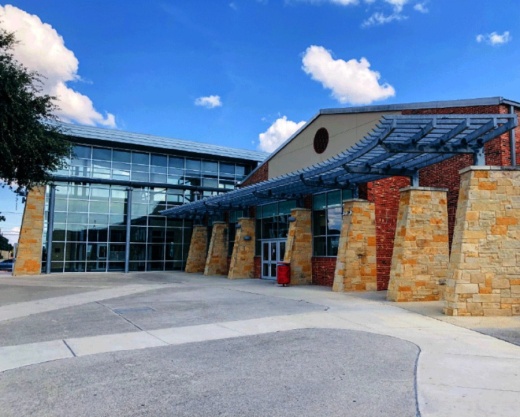Community demand for Comal ISD officials to address racial diversity concerns has come on the heels of an email sent Aug. 17 by CISD board President David Drastata.
In the email to Canyon High School’s athletic booster-club parents, Drastata, who is also the booster club president, referred to COVID-19 as “the China virus.”
The pejorative reference sparked concern among some parents, teachers and students who believe the term is racist and can lead to animosity toward those of Asian descent.
“I felt that if the board president could use a slur like this so lightly, that it would probably mean other people in the community are referring to the virus this way, too,” said CISD parent Morena Hockley, whose husband is Filipino American and sons are student-athletes at Canyon High School.
On Aug. 27, Drastata apologized on the Canyon Athletic Booster Club website, but Hockley said the incident, along with insulting comments left by a CHS teacher on a Facebook post she made expressing her worries, prompted her to share her experiences with the community and school board.
“I told [Drastata] that [his supporters] need to hear directly from him why it’s not OK to say ‘China virus’ and why we need to be more inclusive,” Hockley said. “As a result of this experience, I’ve had lots of students and teachers and parents contact me privately, so we've kind of built this little support group.”
During the public comment portion of CISD’s Sept. 10 meeting, the school board heard from CISD parents and students who shared personal experiences with racism within the district. The district also heard comments from community members wishing to support Drastata and his apology.
Jessica Edwards, whose stepsons are African American students at CHS, said as part of one incident, someone left fried chicken in one of her stepsons’ gym locker, and his coach downplayed it as a joke.
“The coach was like, ‘Oh, it’s not a big deal, they’re probably just playing,’ and [my son] was like, ‘No, that’s racist,’” Edwards said, adding attempts made by the family to press the matter with school faculty resulted in the same response, and her son was even benched during some games.
“When parents have gone to the administration, they’ve been told it was just a joke or they were just kidding,” Hokley said. “[Students] keep getting the benefit of the doubt, but kids of color aren’t getting the same treatment.”
Developing solutions
A common sentiment expressed by attendees during the Sept. 10 meeting was a desire for the district to continue conversations surrounding diversity, implement diversity training, hire a director of diversity and intentionally hire more people of color to fill staff positions.
“We can’t always show up after something bad happens. We have to start showing up where they know that our presence is known,” Edwards said. “Diversity directors are so important when there is such a small minority population because [students of color] don’t have anyone to turn to.”
According to data from the Texas Education Agency, 43.19% of CISD students identified as African American, American Indian, Asian/Pacific Islander or Hispanic during the 2018-19 school year, and 19.79% of CISD teachers were part of the same demographics.
“Comal County is changing. It’s not 95% white kids anymore,” Edwards said. “We can either be prepared and get ahead of this, or we can be caught behind trying to catch up 15 years later.”
The student population at CISD has been trending more diverse in the last decade. Data from the TEA shows the population of white students at CISD was 57.76% in the 2011-12 school year—nearly 5% higher than the 53.29% it was during the 2018-19 school year.
Though Drastata was prohibited by state law from responding to public commentary on nonagenda items, Superintendent Andrew Kim said the district is in the process of creating an advisory committee on student inclusion, equity and diversity.
“The way I would like to approach this is not necessarily a quick reaction; rather, [it would be] a sustained long-term work,” Kim said. “I think if we are really intending on doing this right, then we are going to have to take these incremental steps going forward, and hopefully we can accelerate that as we get ourselves together in terms of how we want to structure [the council].”
Kim said he has begun conversations with district staff, teachers and board members to pinpoint key concerns among families and students to begin planning districtwide and campus-level solutions, but there is not yet a definitive timeline for the next steps.
Hockley attended the first meeting of the CHS Diversity Council on Sept. 11, at which student leaders from campus groups including the Black Student Union, Jolt, the Gay Straight Alliance and Student Council met to discuss how to make the campus more inclusive.
“I hope that this group can kind of be like a template for other campuses because I think every campus needs this, not just Canyon High School.” Hockley said.
District employees have shared with Hockley that diversity training and actively hiring more diverse employees are options that are being discussed, though no solid plans have been shared publicly, she said.
“As far as the board and the district, I would love to see them be more open with their thought process and their planning,” Hockley said. “Adding the issue of diversity to a future board meeting so that people know that's on the agenda and they can come speak on it would help a lot.”
For Edwards, creating support networks for all minority groups in the school district and the broader community will be the most effective way to overcome issues like this.
“Having that supportive environment I think does more than even having a diversity director,” Edwards said. “I don't think it just falls with education; it falls with almost every sector, and so that's why the Diversity Council is working on trying to come up with how [we can] figure out what the best practices are.”





